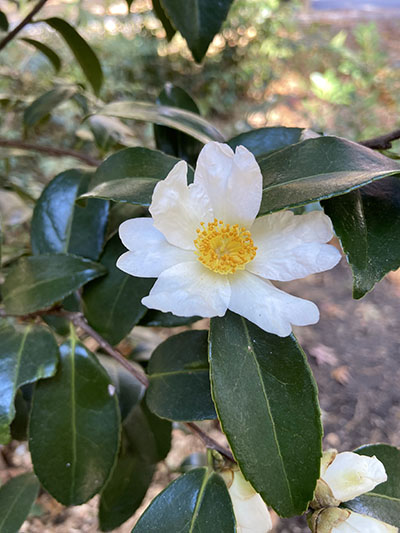
Plants of the Week: October 28

Hamamelis virginiana – common witchhazel
I was recently in the northwestern corner of Connecticut where the state meets with Massachusetts and New York. This part of the Mount Washington State Forest is home to Mount Frissell, whose peak resides in MA but along the slope is the highest point in Connecticut. This goal of mine, getting to all the state highpoints has brought me to many unique environments, high elevations, middle-of-nowhere midwest prairie, and deep forests. But at all these places, I’ve never been as delighted as I was, scrambling up the rocky trail, to pause and turn around to see a forest of in-bloom Hamamelis virginiana.
Glittering through the thick glossy leaves of the Kalmia latifolia (mountain-laurel) and the trunks of oaks and poplars were the yellow, firework-like blooms, softly scenting the chilly fall air. I’d seen plenty of Hamamelis virginiana and other witchhazel blooms here at the Scott Arboretum, but never in a native habit. It was an incredibly special sight and made it one of my favorite high points.
Seeing them in the wild prompted me to check-in on our own common witchhazels here at the arboretum. Our oldest grouping is located behind the Science Center building, along Whittier Place, with other specimens dotted around the Singer Hall Landscape. Northern CT is a little further along seasonally than our 7b here in Swarthmore, so while theirs were in full bloom with no leaves, ours are still holding tight to their leaves while just starting to unfurl their ribbon like petals.

Ginkgo biloba ‘Golden Globe’ – ginkgo
It is lovely to see a tree that needs its space and stands out on its own. One such solo-act is the Ginkgo biloba ‘Golden Globe’ that sits near the Dining and Community Commons.
Selected for its perfect round shape and its dense-branching, this ginkgo has a unique habit, varying from the typically spreading canopy of the straight species. Another fantastic characteristic of this cultivar, is that all ‘Golden Globe’ ginkgos are of a male selection, meaning they will never produce the odorous fruit. I’m so excited to watch this ginkgo as it settles into its yellow fall color, standing out in the arboretum landscape, like a lovely yellow lolly-pop.

Camellia ‘Survivor’ – camellia
Another week of highlighted plants, another camellia! This week’s selection has proven its valor against the harsh winds and freezing temperatures of a winter’s night. Named after surviving a -9°F night in 1985, ‘Survivor’ has earned its right to be considered hardy in USDA zone 6a.
Camellia ‘Survivor’ is a hybrid made by Dr. Clifford Parks in 1985 and is a cross between Camellia sasanqua ‘Narumi-gata’ (sasanqua camellia) and Camellia oleifera (tea-oil camellia). With blooms starting in October, one can expect an upright and dense growing habit and white single flowers about 2.5-3 inches in diameter. With thick, glossy, evergreen leaves, the delicacy of the tissue paper thin petals creates a lovely contrast and a handsome plant.





Inge Daniels
Posted at 08:40h, 21 NovemberI have two Hamamelis virginiana planted side-by-side, acquired from the same nursery. One sheds its leaves before bloom and one retains them into winter. Any ideas why?